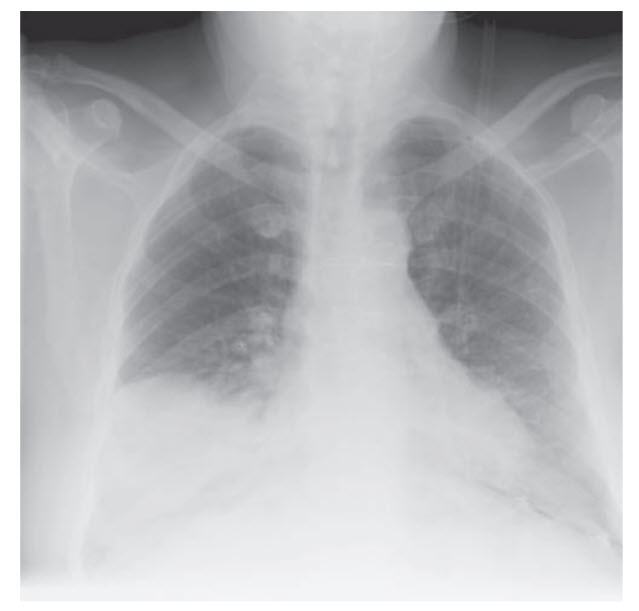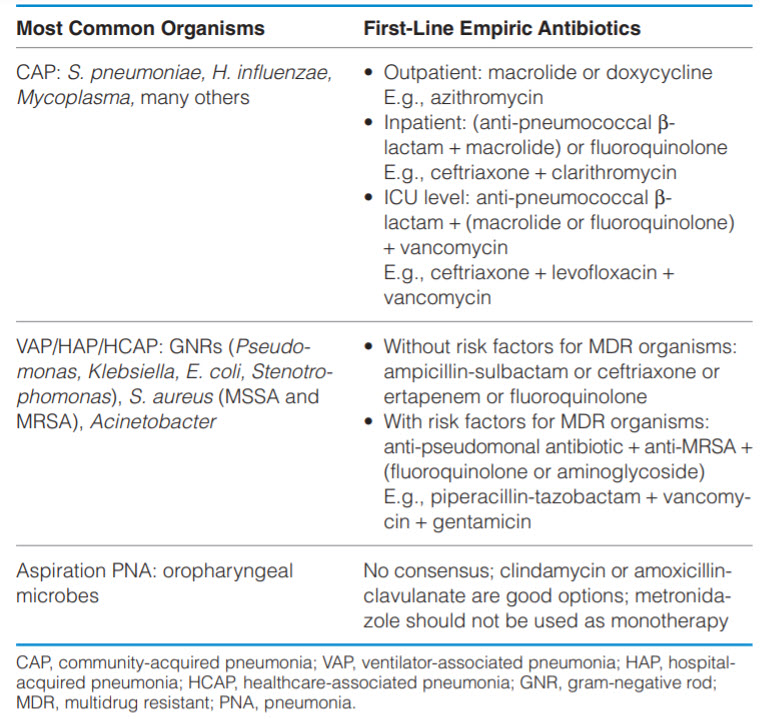Question 1#
A 72-year-old woman is admitted to the hospital for an acute exacerbation of heart failure. She has a history of congestive heart failure (CHF), hypertension, and diabetes. While in the hospital, she is diuresed with IV furosemide and her symptoms improve. However, 3 days later she develops worsening shortness of breath. Her temperature is 38.1°C, blood pressure is 104/68 mmHg, heart rate is 94 beats per minute, respiratory rate is 26 breaths per minute, and oxygen saturation is 92% on room air. A chest x-ray is ordered and is shown in Figure below:

What is the most appropriate empiric treatment?
A. Ceftriaxone and azithromycinB. Ceftriaxone, levofloxacin, and vancomycin
C. Clindamycin
D. Increase the dose of IV furosemide and administer morphine
Correct Answer is B
Comment:
Ceftriaxone, levofloxacin, and vancomycin. In a patient with pneumonia, it is important to first define the type of pneumonia since this identifies the likely organism and the necessary empiric antibiotic therapy. Hospital-acquired pneumonia (HAP) refers to the development of pneumonia >48 hours after admission, with no evidence of pneumonia on admission. A type of HAP is ventilator-associated pneumonia (VAP), which occurs 48 to 72 hours after mechanical ventilation.
Common Etiologies of Pneumonia and Empiric Antibiotic Regimens:

Healthcare-associated pneumonia (HCAP) develops in a patient with recent or ongoing contact with healthcare facilities or personnel (e.g., hospitalized ≥2 days in the last 90 days, lives in a long-term care facility, receives dialysis, etc.). Finally, community-acquired pneumonia (CAP) refers to pneumonia that develops in all other patients. Table 6-1 shows the common organisms causing each type of pneumonia as well as the appropriate empiric antibiotic therapy
(A) Empiric antibiotics for inpatient CAP consist of an anti-pneumococcal β-lactam (e.g., ampicillin-sulbactam, ceftriaxone, cefotaxime, ceftaroline, ertapenem) and a macrolide (e.g., azithromycin or clarithromycin). An alternative is a respiratory fluoroquinolone alone (e.g., levofloxacin, moxifloxacin). (C) Clindamycin is a good agent to use for suspected aspiration pneumonia and may be used as monotherapy. (D) This answer would be correct if the patient’s heart failure symptoms were not improving; however, the presence of fever and consolidation on chest x-ray indicate pneumonia.